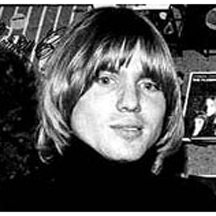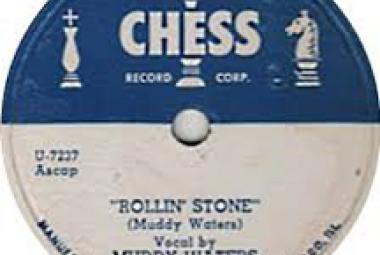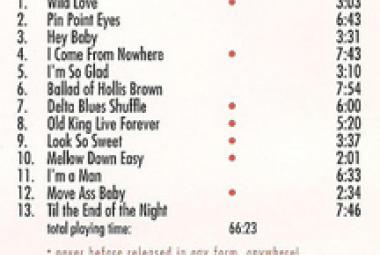(New full-length album by Hollis Brown, this month’s Under-Appreciated Rock Band, released on March 5, 2013 on Alive Records)
One name that has come up repeatedly in these 40-odd posts is Greg Shaw, a widely respected music historian and the founder of Bomp! Records – which also includes the labels AIP Records, Voxx Records, Total Energy Records, and Alive Naturalsound Records (usually just called Alive Records) – and their associated Bomp! mailorder music service. It would not surprise me at all if I haven’t mentioned Greg Shaw in a third of these UARB articles. In addition, more than a few of the Under-Appreciated Rock Bands have released albums or EP’s on one of the Bomp!-affiliated labels. If I also included the albums on non-Bomp labels that I ordered through the Bomp! mailorder service, close to half of the UARB’s and UARA’s would likely have a Bomp! connection.
At least as important as Greg Shaw’s work as a music historian and rock critic are his many writings about the future of rock and roll; these were mostly but not entirely published in the hundreds of newsletters and magazines that he put out over the years. Shaw had strong ideas about where rock should be heading; and, not incidentally (and not coincidentally either), he was present for the birth of punk rock, new wave, power pop, psychedelic revival, and other rock genres. Most rock journalists simply report what is going on; Greg Shaw was one of the few who attempted through his writing and his record labels to actually steer the music itself.
No rock music fan could fail to notice that other musical forms have been pushing rock and roll from the musical mainstream; this is particularly true over the past 20 to 25 years. Country, hip hop, boy bands, teen pop – all of these musical genres and more arose, expanded or were revived over this period, and yet a poll shown on the CBS Sunday Morning television program still shows rock music as being America’s favorite, though not by much: At the moment, rock edges out country by 23% to 21%.
* * *
(What? Stuff, the compilation album that introduced me to the UARB for July 2010, the Eyes, released in 1998 on Bomp! Records)
Many of the seminal bands in these rock movements released albums on the Bomp!, Voxx, Alive, or Total Energy labels; most of them are not household names by any means, but they are recognized by those in the know as being important bands that shaped the history of rock and roll. Some of these better-known bands and artists are the Romantics, the Modern Lovers, the Dead Boys (and Stiv Bators individually), the Plimsouls (and Peter Case individually), the Beat (and Paul Collins individually), the Stooges (and Iggy Pop individually), Devo, Nikki Sudden, the Black Keys, and Soledad Brothers.
I have collected most or all of the albums in several of the various series of garage rock and psychedelic rock compilation albums that Greg Shaw has released in the past few decades, including Pebbles, Rough Diamonds, Highs in the Mid-Sixties, English Freakbeat, and Electric Sugar Cube Flashbacks. Pebbles in particular is often cited as one of the chief inspirations behind the punk rock movement of the mid-1970’s – even more so than the better-known Nuggets album. Thus, even Greg Shaw’s historical albums have helped direct the future of rock music.
From my perspective, I found out almost immediately that Greg Shaw and I have the same basic taste in music, and that is why I continue to come to the well decades after I first encountered his records with the Pebbles, Volume 9 LP and the Pebbles, Volume 10 LP.
* * *
(Retrospective album of the Breakaways, the UARB for April 2010, released on November 10, 2009 on Alive Records)
Greg Shaw died too young in 2004, but his legacy lives on to this day. Greg Shaw and his wife Suzy Shaw eventually divorced, but she and her current husband Patrick Boissel continue to operate Bomp! Records. Boissel is actually the founder of their most active label, Alive Records and previously operated Marilyn Records in the 1990’s. Bomp! Records celebrates its 40th anniversary next year and advertises itself as the oldest independent record company in the nation.
In my dealings over the years with the Bomp! mailorder service, I have gotten to know Suzy Shaw. I was flattered that, in the advertising copy for some of the albums Bomp! was advertising, she was using some of the articles that I had written in Wikipedia on the Pebbles albums and on the Stiv Bators compilation album, L.A. L.A.; and I told her so once when I was making one of my many orders. She wrote back that she had wondered who had done those great write-ups, and she even sent me an autographed copy of the Bomp 2 – Born in the Garage book in appreciation. We have swapped emails many times over the years.
* * *
(Ear-Piercing Punk, the compilation album that introduced me to the UARB for April 2011, Bohemian Vendetta, released clandestinely in 1979 by Bomp! Records on Trash Records)
Greg Shaw began as an amateur journalist and wrote hundreds of newsletters and fanzines early in life; many revolved around science fiction and the work of Lord of the Rings author J. R. R. Tolkien, but they also included one of the earliest rock magazines that Shaw started in 1966 with David Harris, called Mojo Navigator Rock and Roll News. The magazine was said to be an inspiration for Rolling Stone magazine; Greg Shaw wrote for Rolling Stone also, but he and RS founder Jann Wenner apparently didn’t get along that well.
* * *
(Second album by the UARB for January 2011, Hacienda, released on April 6, 2010 by Alive Records)
By the way, let me give me a shout-out and congratulations to Hacienda for being featured in a current series of television commercials for the “cool ranch” promotion by Taco Bell.
After Greg Shaw and Suzy Shaw moved to Los Angeles, the first issue of a new magazine came out – at the very end of the 1960’s (in January 1970) – under the title of Who Put the Bomp. A loose-knit organization called Rock Enthusiasts Amateur Press (R.E.A.P.) – which only had a membership of around 13 – was started by Louis Morra, and he invited Greg Shaw among others to rush a fanzine to press. Greg Shaw was an inveterate publisher in this period and was also publishing several other newsletters having various arcane purposes; these include Karnis Bottle’s Metanoia, Liquid Love, Alligator Wine, and Rock You Sinners!.
The name is taken from “Who Put the Bomp (in the Bomp, Bomp, Bomp)”, a Top-40 hit by Barry Mann. This was basically a one-hit wonder, but Mann always concentrated mostly on his songwriting, and he is well known for numerous songs that were co-written with his wife Cynthia Weil – “Blame it on the Bossa Nova” by Eydie Gorme, “Hungry” and “Kicks” by Paul Revere and the Raiders, “Here You Come Again” by Dolly Parton, “Looking through the Eyes of Love” by Gene Pitney originally, etc. Others that he co-wrote with others include two hit duets by Linda Ronstadt, “Don’t Know Much” (with Aaron Neville) and “Somewhere out There” (with James Ingram); “You’ve Lost that Lovin’ Feelin’” by the Righteous Brothers and also Daryl Hall and John Oates; and “On Broadway” by the Drifters and later by George Benson. Barry Mann’s songwriting credits include an astounding 635 songs.
“Who Put the Bomp (in the Bomp, Bomp, Bomp)” – which was co-written by Barry Mann and Gerry Goffin (an even more famous songwriter who co-wrote numerous 1960’s classics with his then-wife Carole King) – parodied and also honored the doo-wop songs of early rock and roll. The singer is thanking the authors of these songs who helped his girl fall in love with him. The “bomp bomp bomp” itself comes from the Marcels’ marvelous, over-the-top version of “Blue Moon”; another famous nonsense chorus, “rama lama ding dong” is also referenced, from “Rama Lama Ding Dong” by the Edsels.
No known copies of this first issue are known to exist; it probably contained only 2 to 6 pages. Greg Shaw himself thought that another fanzine called Trash was the best among what he termed a “terrible” bunch. But from these quite humble beginnings grew a substantial rock and roll empire.
* * *
(Album by the UARB for December 2012, the Invisible Eyes, released on November 22, 2005 on Bomp! Records)
The idea for the magazine originally was that the title of each issue would be taken from the name of a great rock song; thus, the second issue was to have been called Da Doo Ron Ron. Greg Shaw was persuaded that this was not a good idea for an ongoing publication, so the issue was named Who Put the Bomp #2, with Da Doo Ron Ron as the subtitle. This practice was dropped after the third issue, although the initials R.I.A.W.O.L. were frequently present on the front page, standing for “Rock Is a Way of Life”.
“Da Doo Ron Ron” was a #3 hit in 1963 for the girl-group the Crystals; and it was written by another famous 1960’s songwriter couple, Jeff Barry and Ellie Greenwich, together with Phil Spector (now infamous for his 2009 conviction for a murder in his home in 2003). This song is a classic example of Spector’s legendary “Wall of Sound” production technique.
The third issue of Who Put the Bomp was subtitled Whenever a Teenager Cries; whereas I grew up with the other two songs and loved them both, I wasn’t familiar with this song. Their 1964 song “Whenever a Teenager Cries” was by one of Greg Shaw’s favorite girl groups, Reparata & the Delrons. (I did find the song on YouTube, and it is another great one without a doubt).
The songwriter is Ernie Maresca; while I didn’t really know that name either, I certainly know his work: He wrote or co-wrote several of the biggest hits by Dion, including “Runaround Sue”, “The Wanderer” and “Donna the Prima Donna”. Maresca was also the songwriter behind one of my own favorite lesser known early 1960’s songs, “Party Girl” by Bernadette Carroll. I stumbled upon the song again on a compilation album not that long ago.
* * *
(Retrospective album by the UARB for August 2012, Phil and the Frantics, released in 1985 as Rough Diamonds, Volume 3 on Voxx Records)
Now, of all of the songs that Greg Shaw could have used to name and then subtitle his magazine, two of them came out in 1963, and the other in 1964, though that one could just as easily have been made in 1963. Why 1963? Greg Shaw was 14 in 1963; and, according to neuroscientist and author Daniel Levitin in his book, This is Your Brain on Music, this is when the brain is most susceptible to the influence of music. As quoted in Bomp 2, Levitin writes: “Part of the reason we remember songs from our teenage years is because those years were times of self discovery, and as a consequence, they were emotionally charged.”
Many years later, Greg Shaw wrote in 2001: ”One of my favorite phases of 60’s garage was 1963, when nobody had ever heard of England, and songs like ‘Louie Louie’ [by the Kingsmen] and ‘Surfin’ Bird’ [by the Trashmen] were drawing on 50’s R&B to create something new.”
* * *
(Retrospective album by the UARB for December 2010, the Poppees, released on April 20, 2010 on Bomp! Records)
I was born a couple of years later than Greg Shaw, so I turned 14 in 1965. By then, the Beatles and the Rolling Stones were old news; and while I was still paying attention, what was really grabbing me at the time were American artists and bands. First and foremost was “Like a Rolling Stone” by Bob Dylan; that song – plus the flip side “Gates of Eden” that was nearly as long and every bit as good – captivated me in a way that I just couldn’t keep quiet about. Other great folk-rock sounds of that period included the release of the cover of Dylan’s “Mr. Tambourine Man” by the Byrds and the revamped “The Sounds of Silence” by Simon and Garfunkel. Bob Dylan himself preferred the Byrds’ cover to his own recording of “Mr. Tambourine Man”; but in my usual contrarian way, I preferred Dylan’s original – it was a lot longer for one thing.
These songs were followed closely by the glorious sounds of garage rock and psychedelic rock that were then in their infancy. Songs like “Pushin’ Too Hard” by the Seeds, “We Ain’t Got Nothin’ Yet” by Blues Magoos, and “I Had Too Much to Dream (Last Night)” by the Electric Prunes really made an impression on me. It wasn’t until I picked up the Nuggets collection and then the numerous Pebbles albums that I plumbed the depths of this scene, but it was by no means brand new to me either.
* * *
(Third album by the UARB for November 2012, Thomas Anderson, released on October 30, 1995 on Marilyn Records)
Greg Shaw continued publishing Who Put the Bomp with ideas both modest and grandiose; in the sixth issue for instance, he introduced a bold mission statement: “Prelude to the Morning of an Inventory of the 60’s”. The name of the magazine would eventually be shortened to just Bomp!, and the 22nd issue that was due to come out in 1981 was never published.
Shortly after Greg Shaw’s death, his ex-wife and business partner Suzy Shaw had her own mission: to cement Shaw’s place in the rock and roll firmament. The result was a gorgeous 2007 hardbound book called Bomp! that was subtitled Saving the World One Record at a Time. In the “Dedication”, Suzy Shaw writes: “The idea for this book came in the early 1980s right after BOMP! magazine first folded. . . . When Greg died I knew it was the most important job I had, as this book is not just the story of BOMP! and Greg Shaw, but a unique document of a time, place, and perspective in the history of rock and roll.”
The co-writer is one of my very favorite musicians (and a prolific writer as well), Mick Farren of the bold English underground rock band, the Deviants. The book opens with the modestly titled “Introduction” by Farren that is as good an overview of the rock music scene as any that I have ever read.
Two years later, Suzy Shaw and the editor of Ugly Things magazine, Mike Stax edited another book, Bomp 2 – subtitled Born in the Garage and sub-subtitled Greg Shaw and the Roots of Rock Fandom 1970-1981!. This book looks a lot like a big issue of Ugly Things and consists of a detailed catalogue of Greg Shaw’s publications over that period, and numerous excerpts from Who Put the Bomp and the other fanzines that were published over this period that were not included in the first book. These books are among my most treasured publications, and they are both autographed by Suzy Shaw.
* * *
(Retrospective album by the UARB for June 2011, the Unknowns, released in 1994 on Marilyn Records)
The genesis of the Bomp! mailorder service came about from the way that Greg Shaw and many of the early collectors found records in those days: Old albums and 45’s were so available and so cheap that many times, Shaw would simply buy several boxfuls and then come home and see what was there. Before long, they were offering the duplicates to friends, then acquaintances, then through ads in his various ’zines. The prices were often about what he paid, 10¢ or so; but times change, just as they have on the recent MetLife ads featuring the Peanuts gang: “Everything can’t be 5¢ (or 10¢)!”
Greg Shaw was a visionary and a legend, and he also had a genius I.Q. of 240 (as I recall). However, he wasn’t good at everything, particularly the business side of Bomp! Records. . . . Well, I certainly can’t tell this part of the story any better than Suzy Shaw did in the Bomp 2 book:
“Being more of a historian than a collector, [Greg Shaw] often said that he hated collectors. All that really mattered to him was getting the general information about the record – it was meant to be played once for the purposes of knowing what type of music it was. If a record was so shattered that it had to be scotch-taped together (this was not unheard of in his collection), it was at least useful for knowing the label, title and catalogue number, and he would file it away with the others without hesitation. So legendary was the generally horrendous condition of his vinyl that certain record dealers still use a grading system to this day that starts with ‘Mint’ and ends with ‘Greg Shaw Minus’. [I have been to record stores myself that posted this grading system.]
“Thus it was no surprise that Greg had not the slightest qualm about merely tossing a customer’s order into a paper grocery bag, stapled at the top to keep the records from spilling out (that’s if you were lucky). The odds of a buyer getting what they wanted or having the vinyl arriving unbroken were quite slim. This was bad enough when you were dealing with friends, but the mailing list had begun to branch out to include the general public. These newcomers had the annoying habit of not only insisting that they receive the exact records that they had paid for, but getting them in one piece, and soon enough the angry letters and threats began pouring in. Never one to be bothered by such minor details, or the law (federal, state and local!), Greg simply ignored the whole mess, continuing as he had before, until the registered letters from the Post Office began arriving, and the government was actually threatening to file charges. I was nothing short of terrified, and in a move that was to be oft repeated in our lives together, my choice seemed to be between going to prison or to take over that part of the business. And so mail order slid over to my side of the game board for once and for all.”
Well I remember poring over those Bomp! mailorder sheets that would arrive in the mail periodically years ago, listing hundreds of albums and 45’s in tiny print with a few tantalizing words of description. I would circle album after album, and then when it came time to actually write the check, I would have to cull the order back to something that I could actually afford.
When the operation was moved to the Internet – www.bompstore.com/ – I was a little behind the curve and just thought I had dropped off their mailing list for some reason. It is not as tactile an experience anymore, and I kind of miss that. I also might be the very last Bomp! customer that still sends a paper check!
* * *
(May 2013)















